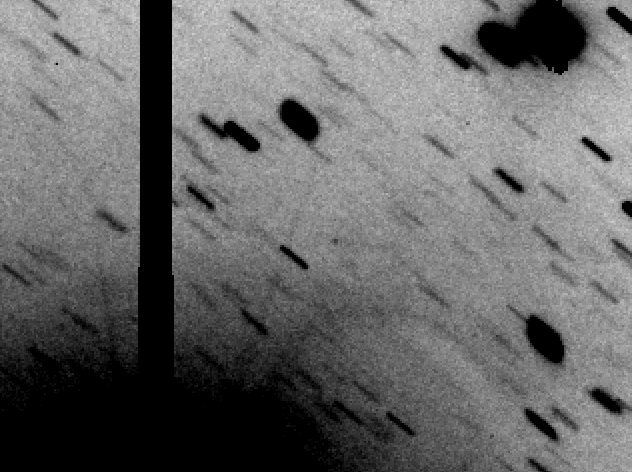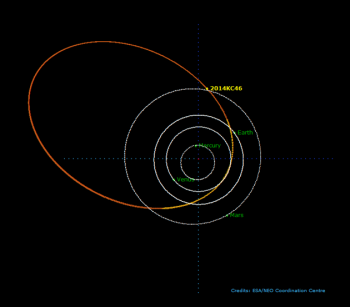The Large Binocular Telescope (LBT), of which the Italian National Institute for Astrophysics (INAF) is a main partner, successfully observed asteroid 2014 KC46 in the nights of 28 and 30 October 2014.

Asteroid 2014 KC46 rediscovered on 28 and 30 October 2014 by a new collaboration between the Italian LBT team and ESA’s NEO Coordination Centre. Credit: LBTO/INAF/ESA
This is one of the faintest Near-Earth Object (NEO) recoveries ever performed. These challenging observations, which pushed the limits of the telescope down to a visual magnitude of 26.3 – extremely faint – was carried out on the nights of 28 and 30 October 2014 by a new collaboration between the Italian LBT team and ESA’s NEO Coordination Centre, located at ESRIN, near Rome.
A ‘recovery’ refers to the case when an asteroid that was previously spotted but not confirmed is lost and then refound and confirmed.
The LBT spotted the 100-metre-size object while it was just beyond the orbit of Mars. The corresponding measurement of its position was sufficient to decrease the uncertainties associated with its orbital path to the point of safely dismissing any possibility that 2014 KC46 might hit the Earth in the near future.
The successful observation of this asteroid was made possible by the unique performance of the LBT. It features a large field of view to entirely cover the uncertainty in the position of the target asteroid, combined with the ability to spot very faint objects (thanks to the twin 8.4-meter mirrors of the telescope).
This result highlights the importance of rapid response for verifying NEO orbits and the effectiveness of the LBT in detecting faint objects having large uncertainties.
The data have been accepted by the IAU’s Minor Planet Center, the official organisation responsible for collecting astrometric data for small bodies of the solar system, and published in the electronic circular MPEC 2014-V35. Both the European NEODyS system and the NASA/JPL-based Sentry system updated their orbit determination and impact monitoring using the new LBT observations, and confirmed the removal of all impact possibilities for the next century.
The Large Binocular Telescope is a facility consisting of two 8.4-meter mirrors on a common mount, located at an altitude of 3200 m on Mt. Graham (Arizona, USA). This telescope is equivalent in light-gathering power to a single 11.8-meter instrument.
The LBT is a collaboration between the Instituto Nazionale di Astrofisica (INAF), The University of Arizona, Arizona State University, Northern Arizona University, LBT Beteiligungsgesellschaft in Germany, Ohio State University, Research Corporation in Tucson and the University of Notre Dame.
The NEO Segment of ESA’s Space Situational Awareness (SSA) programme aims to coordinate and combine information from different sources, analyse them to predict possible impacts with the Earth, assess danger and analyse possible mitigation measures, including the deflection of a threatening asteroid. Within this framework, the ESA NEO Coordination Centre provides data and services on any NEO hazards and coordinates follow-up astronomical observations.


Discussion: no comments